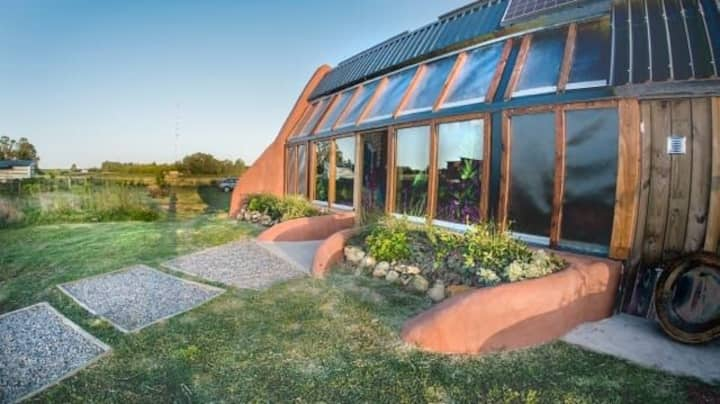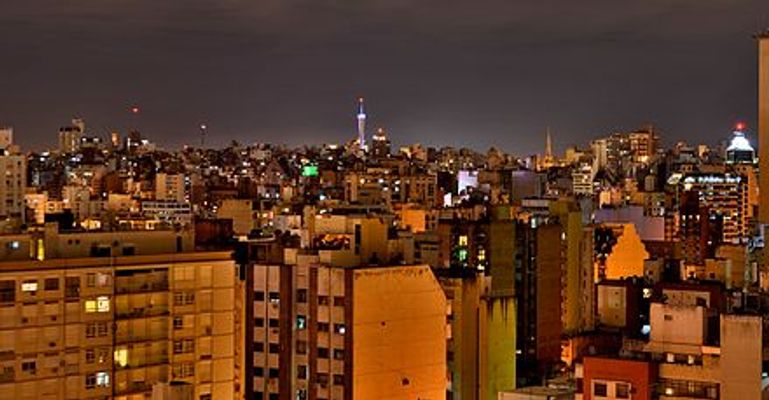
From Wikipedia: Uruguay is the second-smallest country in South America (after Suriname), bordered by Argentina to the west, Brazil to the northeast, and the Atlantic Ocean to the southeast. The country is known for its colonial-era historic districts in Colonia and Montevideo, popular beaches on the Atlantic Coast, and beef production—a former meat processing plant in Fray Bentos is a world heritage site. Calmer and safer than its neighbors, Uruguay is a friendly, easygoing destination.
find another country
Colonia del Sacramento

[from en.wikipedia.org]: Colonia del Sacramento is a city in southwestern Uruguay, by the Río de la Plata, facing Buenos Aires, Argentina. It is one of the oldest towns in Uruguay and the capital of the Colonia Department. It has a population of around 27,000.

Farm stay in Departamento de Colonia · ★5.0 · 1 bedroom · 1 bed · 1 private bath

Caliu Earthship Ecolodge. A different experience [image from Airbnb]

Earthship Hotel Uruguay - Earthship Biotecture

https://d334d4qdfk61ge.cloudfront.net/wp-content/uploads/CALIU-EARTHSHIP-HOTEL.mp4 In February of 2019, Earthship Biotecture conducted an Earthship Academy for more than 60 students who gathered near Colonia Del Sacremento, Uruguay. A Star studded Earthship Crew tie Lou, Rory, Phil, Harry, Mo, Spider, Ralph, Dan, Michael and so many more and with the students focused on learning all about Earthships from the legends […] [image from Earthship Biotecture]

JOSE IGNACIO--THE WORLD'S BEST BEACH TOWN

A guide of Jose Ignacio Uruguay, the world's best beach town. The best restaurants in Jose Ignacio. The best beaches Jose Ignacio. Best hotels in Jose Ignacio. [image from You Should Go Here]

Montevideo
Average temperatures
Jan
28°C18Precipitation: 87 mm
Feb
28°C18Precipitation: 102 mm
Mar
26°C16Precipitation: 105 mm
Apr
22°C13Precipitation: 86 mm
May
19°C10Precipitation: 89 mm
Jun
15°C8Precipitation: 83 mm
Jul
15°C7Precipitation: 86 mm
Aug
16°C8Precipitation: 88 mm
Sep
18°C9Precipitation: 94 mm
Oct
21°C12Precipitation: 109 mm
Nov
24°C14Precipitation: 89 mm
Dec
27°C16Precipitation: 84 mm

Punta del Este
Average temperatures
Jan
25.2°C18.1Precipitation: 75.4 mm
Feb
25.1°C18.4Precipitation: 84.8 mm
Mar
24°C17.6Precipitation: 79.3 mm
Apr
21.2°C14.9Precipitation: 84 mm
May
18.2°C12.1Precipitation: 91.4 mm
Jun
14.8°C9.5Precipitation: 80.3 mm
Jul
14.4°C8.7Precipitation: 90.3 mm
Aug
14.7°C8.8Precipitation: 93.9 mm
Sep
16°C9.9Precipitation: 93.1 mm
Oct
18.4°C11.4Precipitation: 85 mm
Nov
21°C14.1Precipitation: 86.8 mm
Dec
23.8°C16.4Precipitation: 66.6 mm

Colonia
Average temperatures
Jan
27°C19Precipitation: 92 mm
Feb
27°C19Precipitation: 116 mm
Mar
25°C17Precipitation: 125 mm
Apr
22°C14Precipitation: 91 mm
May
18°C11Precipitation: 78 mm
Jun
15°C9Precipitation: 66 mm
Jul
15°C8Precipitation: 69 mm
Aug
16°C9Precipitation: 76 mm
Sep
18°C10Precipitation: 80 mm
Oct
21°C13Precipitation: 113 mm
Nov
24°C15Precipitation: 108 mm
Dec
27°C18Precipitation: 87 mm

Rivera
Average temperatures
Jan
30.5°C18.7Precipitation: 136.4 mm
Feb
28.7°C18.4Precipitation: 160.4 mm
Mar
27.3°C17.2Precipitation: 133.1 mm
Apr
23.7°C14.1Precipitation: 181.9 mm
May
20.5°C10.8Precipitation: 148.3 mm
Jun
16.9°C8.8Precipitation: 110.7 mm
Jul
16.6°C8.1Precipitation: 91.2 mm
Aug
19.9°C9.3Precipitation: 87 mm
Sep
20.6°C10.3Precipitation: 130.9 mm
Oct
23.8°C13.2Precipitation: 149.4 mm
Nov
26.5°C15.1Precipitation: 150.4 mm
Dec
29.6°C17.3Precipitation: 125.2 mm

Salto
Average temperatures
Jan
32.8°C19.7Precipitation: 118.2 mm
Feb
31°C18.9Precipitation: 129.6 mm
Mar
29.3°C17.4Precipitation: 157.7 mm
Apr
24.9°C14Precipitation: 162.2 mm
May
21.1°C10.6Precipitation: 95.8 mm
Jun
18.2°C8.4Precipitation: 76 mm
Jul
18.1°C7.6Precipitation: 53.1 mm
Aug
20.5°C8.7Precipitation: 58.7 mm
Sep
22°C10Precipitation: 86.6 mm
Oct
25.3°C13.4Precipitation: 134.2 mm
Nov
28.2°C15.5Precipitation: 141.8 mm
Dec
31.1°C17.9Precipitation: 125.3 mm

Paysandú
Average temperatures
Jan
32°C18.4Precipitation: 106.1 mm
Feb
30.1°C17.8Precipitation: 125.5 mm
Mar
28.5°C16.6Precipitation: 137.8 mm
Apr
24.1°C13.4Precipitation: 158.8 mm
May
20.2°C10.1Precipitation: 102 mm
Jun
17.1°C7.6Precipitation: 68.3 mm
Jul
17°C6.9Precipitation: 56.1 mm
Aug
19.2°C8.1Precipitation: 55.3 mm
Sep
20.7°C9.3Precipitation: 71.5 mm
Oct
24.1°C12.3Precipitation: 121.3 mm
Nov
27°C14.5Precipitation: 123.1 mm
Dec
30°C16.8Precipitation: 112.9 mm

Brazil
No climate information available.








